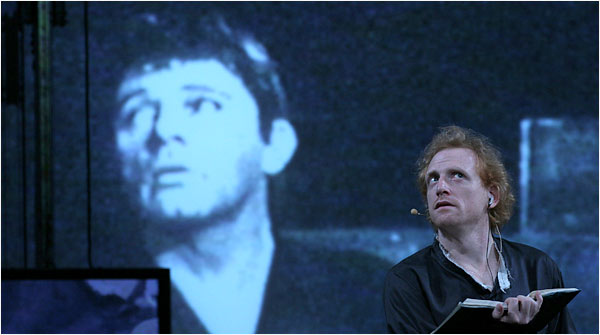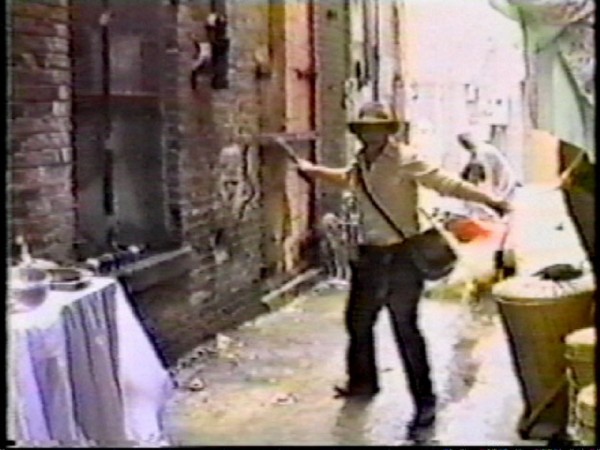From time to time, the Institute returns to thorny and intractable thought experiments. One that’s been kicking around for a long time is what we’ve called the “Communist Manifesto problem”: the problem of representing a book and the conversations it engenders over time, conversations which may grow to include other books. (The Communist Manifesto would be a particularly knotty text to render because it’s had so many cultural repercussions. See here and here for past references on this blog.) It’s a good thought experiment because it’s too big to be easily solved, but aspects of it come up fairly frequent basis. This past week, I found myself thinking about a particular facet of the Communist Manifesto problem: how we think about re-enactment in the age of the archive.
On Wednesday night, I went to see the Wooster Group’s production of Hamlet. I’m not especially qualified as a theater critic (I’m sure others here can say more intelligent things than I), but the central thrust of this production is simple enough: the actors performing Hamlet perform it in front of video of the 1964 filmed version of the play starring Richard Burton. The Burton version is a filmed play, a form intended to bring theater to the theaterless masses that never quite caught on; the Wooster Group’s actors expertly mime the 1964 actors, and sets are moved balletically to match changes in camera angles in the film. Often the original actors are digitally edited out of the film in whole or in part. It’s a clever idea. Hamlet is as familiar to us as any play can be. Even if you’ve never seen another dramatic or filmic production of the play, the language can’t be escaped: in some stretches, every line has been borrowed as a title for something else. It’s lousy with resonances. We can’t watch Hamlet as a self-contained work of art any more than we can look at the Mona Lisa. The Wooster Group’s production makes this explicit: when we watch Hamlet, we’re watching it against the army of other Hamlets we’ve seen.

This has always been an issue with certain well-known works: Hamlet‘s been omnipresent for a long time. The availability of a digital archive, however, has foregrounded this. Before film, theatergoers would be measuring productions against memories of previous productions they’d seen. Now we don’t need to rely on memory: a dozen filmed versions of Hamlet can be queued on Netflix without any trouble, to say nothing of the 4,700 videos that are the results of a YouTube search.
Another cover version: on Thursday night, I went over to Anthology Film Archives to see Raiders of the Lost Ark: The Adaptation. From 1982 to 1989, a group of teens in Mississippi filmed their own scene-for-scene version of Spielberg’s Indiana Jones movie, corralling their friends to play Egyptians, family dogs to play monkeys, and laboriously recreating all but one of the original stunts: they decided there was no way to film a Nazi decapitated by an airplane’s propellor without it looking cheesy, so they left that out. The film & sound quality is muddy, to say the least but one can’t help but be impressed by what they managed to do. It’s clear that an astonishing amount of work went into the film, still more when you realize that they didn’t have a copy of the original on video to work from. And spending seven years on the project: my youth appears pale and lazy by comparison. Strangely, the makers of the film only bothered to show it once before its rediscoveryfour years ago.

Once you start thinking about the idea of re-enactment, you start seeing it everywhere. Maybe the argument could be made that we’re in a cultural moment devoted to re-enactment. Much of what we write off as novelty can be put into this category. The Internet recently was excited about old people re-enacting iconic photos of the twentieth century; see also choirs of old people performing Sonic Youth’s “Schizophrenia”. Or choirs of small children doing much the same. But less ironic presentations abound: off the top of my head, Japancakes just released a note-for-note country-inflected cover of Loveless, My Bloody Valentine’s seminal drone-rock record. Going further, German new music ensemble Zeitkratzer has played and recorded Lou Reed’s Metal Machine Music. Tom McCarthy‘s excellent recent novel Remainder concerns a wealthy man who maniacally reenacts scenes; McCarthy springs from the art world, which has been interested in re-enactment for a while. Examples spiral on ad infinitum. But there seems to be something in us that wants to see or hear what we’ve seen or heard before again.
These are quickly composed thoughts, and I’m ignoring a great deal; parsing the difference between re-enactment and adaptation could be fiendishly complicated, as might be the role of copyright in all of this, etc. I’ll simply tie this back to the Communist Manifesto problem. I think it’s become apparent that we’re no longer reading texts in isolation: now when we read Hamlet, digital media has made it possible to read any number of possible versions at the same time. The archive presents us with an embarrassment of riches, though I suspect that we still lack the tools to let us make sense of the pile: both to make sense of the growing number of versions of texts and to usefully compare versions. The Wooster Group’s Hamlet can be seen as a close reading of the 1964 Hamlet. But such a one-to-one reading might just be the tip of the iceberg.
if:book
A Project of the Institute for the Future of the Book
